Indigenous
The Quiet Remaking of Canada
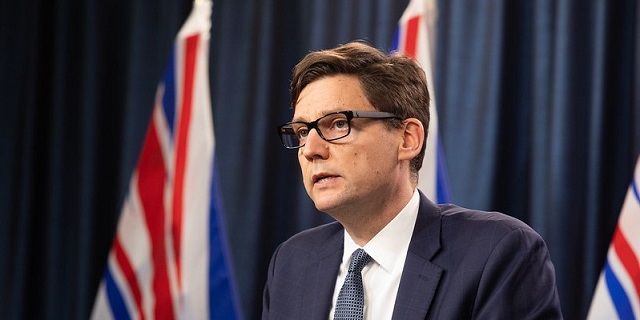
From the Frontier Centre for Public Policy
B.C. residents sat up and took notice of this shocking change when the Eby government announced that it planned to embark on a plan of “co-governance” with its indigenous population – a plan that would have given 5% of B.C.’s population a veto over every aspect of public land useage in the province.
Most Canadians are unaware that a campaign to remake Canada is underway. The conception of that most Canadians have of their country – that it is, one nation, in which citizens of different ethnic, religious and racial groups are all treated equally, under one set of laws – is being fundamentally transformed. B.C. residents sat up and took notice of this shocking change when the Eby government announced that it planned to embark on a plan of “co-governance” with its indigenous population – a plan that would have given 5% of B.C.’s population a veto over every aspect of public land useage in the province.
An emphatic “No” from an overwhelming majority of citizens put an end to this scheme – at least temporarily.
But the Eby government continues to move forward with its plan to transform the province into a multitude of semi-autonomous indigenous nations to accommodate that 5% of the indigenous B.C. population. It is proceeding with a plan that recognizes the Haida nation’s aboriginal title to the entire area of the traditional Haida territory. It would basically make Haida Gwaii into what would in essence be a semi-independent nation, ruled by Haida tribal law.
Many of us are familiar with that exceptionally beautiful part of Canada, where the Haida have lived for thousands of years. Misty Haida Gwaii, formerly known as the Queen Charlotte Islands, is a magical place. Until now, it has been a part of Canada. How would this Haida agreement change that?
Non-Haida residents of Haida Gwaii are probably asking themselves that question. Although they are being told that their fee simple ownership and other rights will not be affected by the Haida agreement, is that true? If one must be Haida by DNA to fully participate in decisions, how can it be argued that non Haida residents have rights equal to a Haida?
For example, the Supreme Court ruled in the Vuntut Gwitchin case that, based on the allegedly greater need of maintaining so-called Indigenous cultural “difference”, individual Indigenous Canadians can now be deprived by their band governments of their rights under the Canadian Charter of Rights and Freedoms on their home reserves and self-governing territories. Simply put, the law of the collective- namely tribal law- will apply.
So, tribal law takes precedence over Canadian law. And will a non-Haida resident be deprived of rights that he would enjoy anywhere else in Canada? For that matter, will an indigenous, but non-Haida, resident have equal rights to a Haida, if he can’t vote in Haida elections? Will this plan dilute, or even eliminate, fee simple ownership for some.
Or this: Does a provincial government even have the power to make such an agreement in the first place? After all Section 91(24) of our Constitution Act gives the federal government responsibility for status Indians.
These are but a few of the many questions that has B.C. residents asking many questions. In fact, the proposed Haida agreement will likely be front and centre in the upcoming provincial election, and could usher in decades of litigation and uncertainty.
But the Eby government has made it clear that the Haida agreement will be the template for others that will follow. Considering the fact that there are at least 200 separate indigenous communities in B.C. this would be a very ambitious undertaking – especially in light of the fact that most of those 200 or so communities are tiny, and almost all are dependent on taxpayers for their continued existence.
Eby is responding to the Supreme Court’s astounding decision that aboriginal title existed, unless it had been surrendered by treaty. The court relied on the Royal Proclamation of 1763 to come to this decision. This was after what was the longest trial in the history of B.C. wherein the trial judge in that case, Chief Justice Allan McEachern, had written a masterful decision finding that aboriginal title did not exist as claimed by the indigenous parties to the action. The Supreme Court went on in subsequent cases to transform Canadian indigenous law and expand section 35 in a manner that emphasized the need for “reconciliation”, the primacy of the collective over the rights of the individual for indigenous people, and the need for indigenous “nation to nation” separateness, instead of assimilation. All of this was done by judicial fiat, with absolutely no input from the Canadian public. Senior Ontario lawyer, Peter Best, describes this radical transformation of Canada in his epic work, “There Is No Difference”.
The unfortunate decision by both the federal government and the B.C. government to adopt UNDRIP, (United Nations Declaration on the Rights of Aboriginal Peoples) and B.C.’s provincial version, DRIPA, (Declaration on the Rights of Indigenous Peoples) further muddied the waters.
What British Columbia will look like in 10 years is anyone’s guess, if the hundreds of indigenous communities in B.C. are successful in obtaining agreements similar to what the Haida negotiate. It also seems very likely that indigenous communities in other parts of Canada will see what the B.C. communities achieved, and want the same additional autonomy and land rights for themselves. In the treaty areas of Canada, namely mainly the prairies and parts of the north, the treaties, in theory, settle the issue. But, if the B.C. Indians succeed in obtaining superior entitlements, the treaty Indians will almost certainly agitate for “modern treaties” that include what the Haida received.
And the citizens of eastern Canada, who believe that their indigenous claims have been permanently settled long ago, are probably in for a rude shock. In “A New Look at Canadian Indian Policy” the late Gordon Gibson quotes a former senior bureaucrat in Indian Affairs who insisted on remaining anonymous. That source says bluntly that all of Canada will be at play if Canada does indeed become the “patchwork of tiny Bantustans” that journalist and visionary Jon Kay predicted in 2001, if we keep going down this “nation to nation” path.
In fact, it is quite possible that every one of the 600 or so indigenous communities in Canada will end up with at least as much “separateness” as the Haida obtained. Canada will be fundamentally transformed into a crazy quilt of mainly dependent reserves governed by tribal law. Surely the Fathers of Confederation didn’t work so hard to end up with such a backward, fractured Canada?
As we see this fundamental transformation taking place in B.C., and then heading eastward, I suspect that Canadians who do not want such a future for their country will start to ask themselves how we arrived at this point. How can a nation be fundamentally transformed with no input from the citizens? Don’t the Canadian people have to be consulted, as we watch our country being transformed by judicial fiat and tribal law? Doesn’t a constitutional process have to be invoked, as happened in the failed Meech Lake or Charlottetown Accords?
Most Canadians believe that history has not been kind to indigenous people, and that indigenous have legitimate claims that need to be addressed. But most Canadians also believe that Canada is one country, in which everyone should be equal.
Canadians also firmly believe that Canada should not be divided into racial enclaves, where different sets of laws are applied to different racial or ethnic groups. In fact, most Canadians would probably support the sub-title of the late Gordon Gibson book cited above: “Respect the Collective – Support the Individual”. Canadians want to see indigenous people succeed, and they support indigenous people in their fierce determination to hold on to their indigenous identity and culture. But they want indigenous people to succeed as Canadians – not in a Canada that has been carved up into racial ghettos, like slices of a cheap pizza.
The Haida agreement is the first highly visible slice – a symbol of a semi-independent “nation” within Canada, that will be governed by rights of the collective tribal law – as opposed to the rights of the individual. That takes us back thousands of years. Before the Haida agreement inspires hundreds of other such racial mini-states within Canada, should Canadians not have a say in what our country is becoming?
Or will we continue to let unelected judges, and faceless bureaucrats, determine our fate?
Brian Giesbrecht, retired judge, is a Senior Fellow at the Frontier Centre for Public Policy
Energy
Ending energy poverty among Indigenous communities is essential

Haida Heritage Centre, Haida Gwaii, Queen Charlotte Islands
From Resource Works
Halting funding for natural gas expansion cut off many Indigenous communities from affordable energy.
Energy poverty in Canada is both an urgent and underreported crisis that is affecting Indigenous, rural, and remote communities across the country.
This is a resource-rich country, but Canada has continually failed to remedy the glaring energy affordability and accessibility gap in these communities. In particular, Indigenous families and households have to face disproportionately high energy costs due to their geographic isolation, a lack of built infrastructure, and neglect during policymaking.
In a report for the Energy for a Secure Future, authored by Heather Exner-Pirot, titled “The Other Energy Security: Addressing Energy Poverty in Canada’s Indigenous Communities,” she lays out these many problems that must be fixed.
It is a dire situation, with remote Indigenous communities being forced to spend over three times more of their household income on energy than the Canadian average. Twenty-six percent of Indigenous households fall into the category of energy poverty, as defined by the Canadian Urban Sustainability Practitioners (CUSP).
Many families spend more than six percent of their disposable income on energy, and this has worsened in recent years as energy costs rise with inflation and other present economic hardships.
Natural gas is the most plentiful and affordable source of household energy in Canada, but it cannot be accessed by many Indigenous communities that lack pipeline infrastructure. Although natural gas is cheaper and cleaner than diesel, propane, heating oil, or wood, the expansion of gas infrastructure into remote regions has hit snags in recent years.
From the 1980s to the 2000s, Ottawa supported the expansion of infrastructure to rural areas in a bid to alleviate affordability issues. However, the shift to reducing emissions and growing renewable energy has resulted in a lack of support for natural gas infrastructure.
This has had the counterproductive effect of leaving Indigenous communities with higher costs and higher emitting fuels like heating oil and diesel due to a lack of alternatives. As a source of energy, diesel is handy and reliable, but is expensive, heavily polluting, and expensive to transport into remote areas.
Renewables like solar and wind help to meet climate goals, but they are not feasible in remote northern communities because of their unreliability and high upfront costs. Phasing out fossil fuels in rural and remote Canada is a bad decision for the people affected without a fair transition strategy.
Many of the Indigenous leaders featured in Exner-Pirot’s report expressed grave concerns about the impact of energy poverty in their communities. They cited the many difficult choices that they have to make, such as having to pick between adequate heating or food.
These leaders are frustrated with the decisions made by distant authorities that prioritize ambitious sustainability goals instead of immediate, practical solutions. Many explicitly called for the expansion of natural gas, declaring it to be feasible, cost-effective, and cleaner than their current options.
One of the more striking statements is their assertion that withholding federal funding from natural gas projects actively denies Indigenous communities relief from energy poverty.
There is good evidence that reveals the benefits of expanding natural gas.
Red Lake, Ontario saw its energy costs fall by 70 percent once it was connected to natural gas infrastructure. Alberta’s Bigstone Cree Nation formerly used propane for decades, but then saw their energy security and affordability greatly improve after the province expanded the natural gas network.
The O’Chiese First Nation, also in Alberta, has been a model for energy autonomy and energy development, having harnessed its natural gas production for the benefit of the whole community.
Exner-Pirot’s report ends with several clear recommendations:
- Equal treatment of all fuels under carbon pricing to eliminate undesirable incentives
- Expanded eligibility for funding programs to include transitional fuels like natural gas
- Financial support for Indigenous-led energy security projects
- Explicit provincial targets and timelines for natural gas infrastructure expansion, using Ontario’s Natural Gas Expansion Program as a model
There is no debate that Canadian energy policy in Indigenous and remote communities has to change immediately. As they currently stand, they are exacerbating energy poverty by cutting out transitional and practical solutions.
No one-size-fits-all approach works for the countless Indigenous communities that reside in Canada, and they each need a tailored approach that respects their geographic and economic realities, as well as their right to self-determination.
Canadian Energy Centre
RBC says Canada’s Indigenous owned energy projects are ‘economic reconciliation in action’
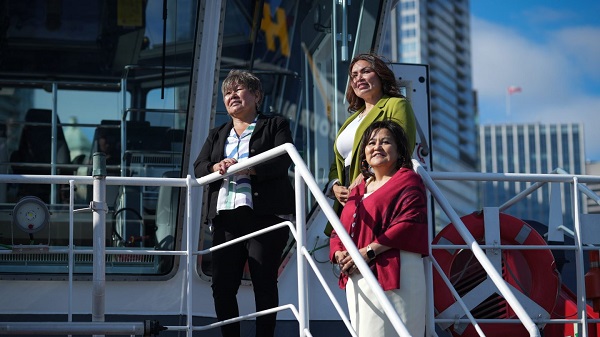
Eva Clayton, back left, President of the Nisga’a Lisims Government (joint venture owner of the proposed Ksi Lisims LNG project), Crystal Smith, back right, Haisla Nation Chief Councillor (joint venture owner of the Cedar LNG project, now under construction), and Karen Ogen, front right, CEO of the First Nations Natural Gas Alliance pose for a photograph on the HaiSea Wamis zero-emission tugboat outside the LNG2023 conference, in Vancouver, B.C., Monday, July 10, 2023. CP Images photo
From the Canadian Energy Centre
As construction gets underway on Cedar LNG, the world’s first Indigenous majority-owned LNG export terminal, a report from RBC highlights the project as a model of successful energy development in Canada.
“We broke a pattern that had existed for over a century,” said Karen Ogen, CEO of the First Nations Natural Gas Alliance.
“First Nations have been at the heart of the LNG opportunity, not on the sidelines or just on the job sites but in the boardrooms helping to make it happen.”
RBC said the Cedar LNG project in Kitimat, B.C. – a partnership between the Haisla Nation (50.1 per cent) and Pembina Pipeline Corporation (49.9 per cent) – is a model for Indigenous economic reconciliation in action.
“Canada’s future growth and prosperity depends heavily on getting Indigenous economic reconciliation right,” said report co-author Varun Srivatsan, RBC’s director of policy and strategic engagement.
“If not, the country’s ability to diversify our resource exports, enjoy independence and resiliency in strategic sectors, and improve productivity, which has lagged that of other countries for years, are all at risk.”
RBC outlined the enormous potential of Indigenous-led energy projects to drive economic growth.

Almost three-quarters of the 504 major resource and energy projects planned or underway in Canada run through or are within 20 kilometres of Indigenous territories.
The value of Indigenous equity opportunity from these projects is estimated at $98 billion over the next 10 years, with oil and gas projects dominating the list at $57.6 billion.
“It’s clear that First Nations are critical to LNG in Canada. It’s First Nations territory from where the gas is extracted in Treaty 8 territory, it’s First Nations territory across which gas is transported via pipeline, it’s First Nations territory where LNG terminals are located, and it’s First Nations waters through which carriers take LNG to market. This is why we say Canadian LNG is Indigenous LNG. And we are going to make history,” Ogen said.
Cedar LNG reached a final investment decision last June, following a permitting process that saw the Haisla Nation directly involved in planning the facilities and operations.
This includes a floating LNG terminal with emissions among the world’s lowest, at 0.08 per cent CO2 equivalent per tonne of LNG compared to the global average of 0.35 per cent. Operations are slated to start in late 2028.
“Our community felt it was important that our values of being Haisla, being Indigenous, were felt through every decision that was being made. That is what makes this project unique,” said Crystal Smith, the Haisla Nation’s elected chief councillor.
Central to the Haisla’s involvement in Cedar LNG are the jobs and ongoing revenues that benefit the nation and neighbouring communities.
This has included support for education and cultural programs and building a state-of-the-art health facility and a new housing development.
“Cedar LNG shows what is achievable when you have a shared vision,” Smith said.
“It is going to mean that my kids and grandkids have a different future from what I or anybody in my generation have experienced in our community. It is going to revive our culture, revive our language, and make us stronger going forward.”
-
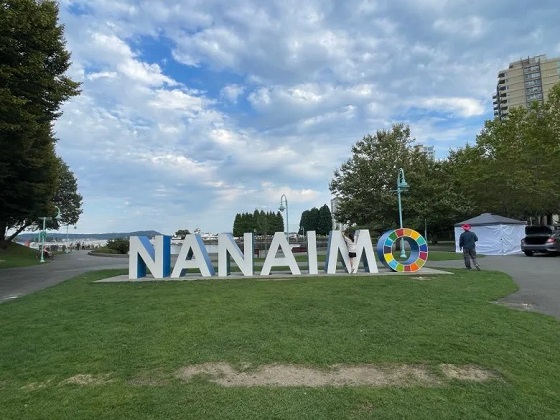
 Addictions11 hours ago
Addictions11 hours agoMan jailed for trafficking diverted safer supply drugs, sparking fresh debate over B.C. drug policies
-
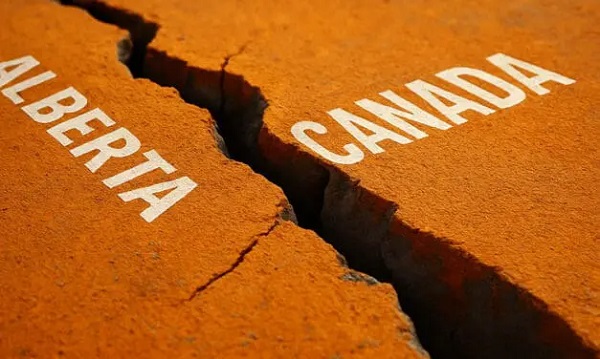
 Alberta13 hours ago
Alberta13 hours agoHow Trump and Alberta might just save Canada
-
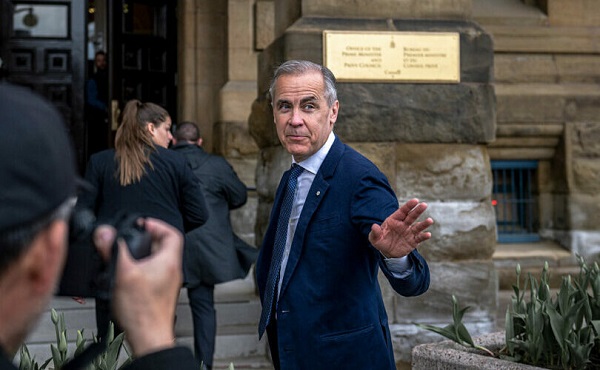
 Business12 hours ago
Business12 hours agoThe Liberals Finally Show Up to Work in 2025
-

 Alberta11 hours ago
Alberta11 hours agoJann Arden’s Rant Will Only Fuel Alberta’s Separation Fire
-

 Bruce Dowbiggin8 hours ago
Bruce Dowbiggin8 hours agoCaitlin Clark Has Been The Real Deal. So Her WNBA Rivals Hate Her
-
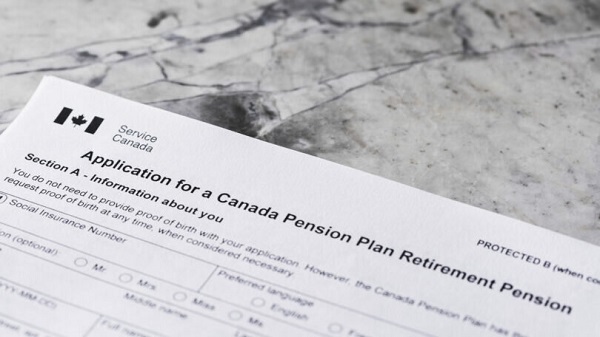
 Banks9 hours ago
Banks9 hours agoCanada Pension Plan becomes latest institution to drop carbon ‘net zero’ target
-

 Daily Caller10 hours ago
Daily Caller10 hours agoThere’s A Catch To California’s Rosy Population Stats
-

 espionage1 day ago
espionage1 day agoTrudeau Government Unlawfully Halted CSIS Foreign Operation, Endangering Officers and Damaging Canada’s Standing With Allies, Review Finds



